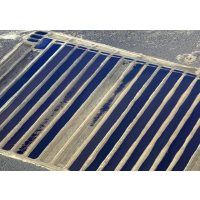Hundreds of Unlined Oil Wastewater Pits in Kern County Have No Permits
 Wastewater pits (photo: Brian van der Brug, Los Angeles Times)
Wastewater pits (photo: Brian van der Brug, Los Angeles Times)
Most of the attention recently given the oil drilling industry’s fracking proclivities has had to do with the questionable practice of injecting the resulting toxic wastewater back into the ground near useable groundwater.
But sometimes the industry doesn’t bother with all that. They just dig long trenches and dump the heavily saline, chemically-enriched wastewater into open, unlined pits—without permits, according to the Los Angeles Times, which got an early peek at a survey conducted by state regulators.
The Central Valley Regional Water Quality Control Board compared notes with the state Division of Oil, Gas and Geothermal Resources (DOGGR) last year and made an unhappy discovery. The state had records on a lot more unlined pits than the board had issued permits for. So the board took to surveying all the pits in Kern County, where 80% of the state’s drilling takes place.
No one is naming names about who the operators of the pits are, but there are numbers.
The water board counted 933 open pits, 578 of which were active. Of those, 208 lacked proper permits. The effect of the unregulated pits on water resources is unknown. They have been around for decades and became more popular after the practice of dumping wastewater in drainage canals servicing agricultural fields fell out of favor in the 1980s.
It is possible there are other pits that neither agency is aware of. There were 2,000 active and idle pits recorded in the Central Valley in 1990, but their popularity is said to be in decline.
The nation’s fourth-largest oil producer produced 130 billion gallons of wastewater to get 8 billion gallons of oil out of the ground in California in 2013, according to a report last November by Andrew Grinberg for Clean Water Action and the Clean Water Fund. The water is chock full of heavy metals, salts, radioactive materials and carcinogens.
Numbers on how much of that water ended up in open pits, as opposed to underground injection or irrigation of crops, are not available because the state didn’t require them until now. The old law required oil companies to provide a monthly statement with “certain information” on water production from each field.
That did not include how much wastewater was produced, what its components were and what the companies did with it. Democratic state Senator Fran Pavley’s SB 1281, passed last September, requires oil companies to report all that stuff on a quarterly basis beginning this year.
At the time of passage, Clean Water Action formally requested that the Central Valley board shut down all unlined open wastewater pits. That didn’t happen.
The state is only now beginning to regulate hydraulic fracturing (fracking), following passage of Senate Bill 4 in 2013. Although the bill was criticized by many as being too little regulation too late, it did set in motion an attempt to at least catalogue what the oil industry was doing and where it was doing it.
Reports over the last six months have slowly revealed the industry’s disposal of billions of gallons of toxic wastewater into healthy aquifers through injection wells. The San Francisco Chronicle reported last month that state records showed government allowed oil companies to drill at least 171 waste-disposal wells into aquifers of drinkable water and 253 more into aquifers that could be (or had been) drinkable with treatment. Another 40 wells pumped water into aquifers for which there is no known data on water quality.
When Grinberg wrote his report, DOGGR was reporting just 432 active unlined pits. Eight-five percent of them were within 1 mile of a surface waterway, 75% were a half-mile away and 62% were within 1,500 feet. The report noted the obvious: “Close proximity to waterways increases risk that harmful spills, seepage, or improper use will contribute to water quality degradation.”
–Ken Broder
To Learn More:
Hundreds of Pits Filled with Oil Wastewater Discovered in Kern County (by Julie Cart, Los Angeles Times)
Hazards of Open Pits for Storing Wastewater from Fracking Is Focus of New Study (by David Hasemyer, InsideClimate News)
In the Pits (by Andrew Grinberg, Clean Water Action/Clean Water Fund)
State Lets Oil Drillers Use Hundreds of Wells to Inject Wastewater into Central Valley Aquifers (by Ken Broder, AllGov California)
- Top Stories
- Controversies
- Where is the Money Going?
- California and the Nation
- Appointments and Resignations
- Unusual News
- Latest News
- California Forbids U.S. Immigration Agents from Pretending to be Police
- California Lawmakers Urged to Strip “Self-Dealing” Tax Board of Its Duties
- Big Oil’s Grip on California
- Santa Cruz Police See Homeland Security Betrayal in Use of Gang Roundup as Cover for Immigration Raid
- Oil Companies Face Deadline to Stop Polluting California Groundwater





